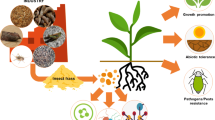Abstract
Simple methods for production of all life stages of the banana weevil on its natural diet, banana rhizome and pseudostem are presented. Their effectiveness, labour demands and applicability for different purposes are discussed. The most effective method for the production of eggs, pupae and adults is the utilization of the rhizome part of suckers, whereas larvae are easier to recover from pseudostem. The hatchability of the eggs produced is high.
Résumé
Des méthodes simple sont présentées pour la production de tous les stades du charançon du bananier dans son régime naturel, le rhizome et le pseudotronc du bananier. Leur effectivité, dépense en temps et applicabilité pour des objectifs differents sont discutées. La méthode la plus effective pour la production d’oeufs, de pupes et d’adultes est celle utilisant le rhizome des rejets, tandis que les larves sont plus facilement recuperees du pseudotronc. Le pourcentage d’oeufs éclorants est élevé.
Similar content being viewed by others
References
Beccari F. (1967) Contributo alla conoscenza del Cosmopolites sordidus (Germar) (Coleoptera, Curculionidae). Riv. Agric. Subtrop. trop. 61, 131–150.
Cuillé J. (1950) Recherches sur le charançon du bananier Cosmopolites sordidus Germar. Institut Français de Agriculture coloniale, Serie technique 4, pp. 225.
Froggatt J. L. (1924) Banana weevil borer. Queensland Agric. J. 22, 154–156.
Longoria A. (1968) Diferencias sexuales en la morfologia externa de Cosmopolites sordidus Germar (Coleoptera, Curculionidae). Ciencias Biologicas 1, 1–11.
Parnitzki P. (1992) Biologische Bekämpfung des Russelkäfers Cosmopolites sordidus (Germar) mit entomopathogenen Nematoden der Gattungen Heterorhabditis und Steinernema sowie Untersuchungen zur Biologie des Schädlings. Doctoral Thesis, University of Bonn.
Roth L. M. and Willis E. R. (1963) The humidity behaviour of Cosmopolites sordidus (Coleoptera, Curculionidae). Ann. Entomol. Soc. Am. 96, 41–52.
SAS Institute (1985) SAS/STAT Guide for Personal Computer, Version 6. Cary, North Carolina: SAS Institute. Pp. 378.
Treverrow N. L. and Maddox C. (1992) The distribution of Cosmopolites sordidus (Germar) (Coleoptera: Curculionidae) between various types of banana plant material in relation to crop hygiene. Gen. Appl. Entomol. 23, 16–20.
Vilardebo A. (1984) Problemes scientifiques poses par Radopholus similis et Cosmopolites sordidus en cultures bananieres de zones francophones de production. Fruits 39, 227–233.
Author information
Authors and Affiliations
Rights and permissions
About this article
Cite this article
Koppenhöfer, A.M., Seshu Reddy, K.V. A Comparison of Rearing Methods for the Banana Weevil, Cosmopolites Sordidus (Germar) (Coleoptera: Curculionidae) on Its Natural Host. Int J Trop Insect Sci 15, 191–195 (1994). https://doi.org/10.1017/S1742758400015447
Received:
Published:
Issue Date:
DOI: https://doi.org/10.1017/S1742758400015447




